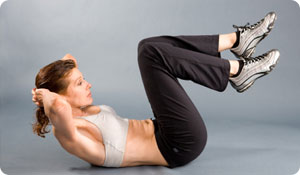
The last decade of fitness has been "all about the core." We've scooped our abs, flattened our spines to the floor, sucked our belly buttons, in and crunched our way to "core stability." Unfortunately, many of us have also yanked the heck out of our backs. An article in the New York Times reports that many sports scientists are reconsidering whether all this attention on deep abdominal muscle strength really does deliver a more powerful core-and if it's even safe.
According to the scientists, many exercises emphasized as "core essentials" have caused us to strengthen just one set of abdominal muscles (the transversus abdominis) and neglect other muscle groups that support our spine. Researchers now say back health is dependent on all abdominal and back muscles working in harmony so none become dominant and pull the spine out of alignment.
Stuart McGill, PhD, a professor of spine biomechanics in the kinesiology department at the University of Waterloo in Canada and a back-pain clinician says that "the "core" remains a somewhat nebulous concept; but most researchers consider it the corset of muscles and connective tissue that encircle and hold the spine in place. If your core is stable, your spine remains upright while your body swivels around it." But, McGill says, the muscles forming the core must be balanced to allow the spine to bear large loads. If you concentrate on strengthening only one set of muscles within the core, you can destabilize your spine by pulling it out of alignment.
The American College of Sports Medicine says many standard abdominal exercises are now "contraindicated" because of the risks they pose to our backs. Their suggestions? Instead of full sit-ups, do bent-knee crunches. Instead of double leg raises, do single leg raises with your opposite foot on the floor and knee bent. Keep your squats to a 90-degree (or more) knee angle.
McGill suggests that a safe core program should include but not concentrate on the abs. He recommends regularly doing just three exercises for balanced core stability. But watch out-don't scoop your abs in or flatten your back to the floor:
Side plank. Start by lying on your side with your legs together, forming a straight line from shoulders to toes. Tighten abdominal and glute muscles, and raise your upper body onto your elbow and eventually, your hand. When you're ready for a tougher workout, raise your upper leg and/or arm. Hold for 15 to 30 seconds, and repeat on opposite side.
Bird Dog. Start on your hands and knees with knees directly under your hips and hands under shoulders. Raise your right hand, and reach straight out in front of you while lifting your left leg straight out behind you. Alternate (left hand, right leg) and repeat for ten repetitions on each side.
Crunches. Lie on your back with one knee bent. Place your hands beneath your lower back for support. Lift your head and shoulders gently, hold briefly and relax. Alternate knees.





